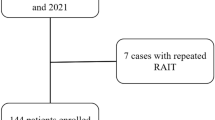Abstract
Computerized technetium-99m thyroid uptake and thyrotropin (TSH) estimation using a sensitive immunoradiometric assay were performed at presentation and following completion of an 18-month course of antithyroid drug therapy in 45 patients with Graves' disease. All patients had increased99mTc thyroid uptake and subnormal TSH levels before the start of treatment. Twenty-two patients developed recurrent hyperthyroidism in a 3-year follow-up period. Of these 22 patients with relapse, 20 had had a persistently increased99mTc thyroid uptake at the end of the course of carbimazole treatment, whereas TSH had remained subnormal in 18 of the 22. All 23 patients who remained in remission until the end of the 3-year follow-up had had normal99mTc thyroid uptake following completion of antithyroid drug treatment. TSH levels had reverted to normal in 19 cases, but remained subnormal in four cases in this group at the end of treatment. The results suggest a high likelihood of relapse in patients who have persistently increased99mTc thyroid uptake and subnormal TSH after a full course of carbimazole treatment. Patients whose99mTc thyroid uptake and TSH levels have reverted to normal are likely to stay in long-term remission. Assessment of99mTc thyroid uptake and TSH levels following completion of carbimazole therapy for Graves' disease offers useful information regarding long-term prognosis.
Similar content being viewed by others
References
Volpe R. Graves' disease: pathogenesis. In: Braverman LE, Utiger RD, eds.Werner and Ingbar's the thyroid. A fundamental and clinical text.. Philadelphia: J.B. Lippincott; 1991:648–657.
Garcia Mayor RV, Paramo C, Luna Cano R, Perez Mendez LF, Galofre JC, Andrade A. Antithyroid drug and Graves' hyperthyroidism. Significance of treatment duration and TRAb determination on lasting remission.J Endocrinol Invest 1992; 15; 815–820.
Hedley AJ, Young RE, Jones SJ, Alexander WD, Bewsher PD, Scottish Automated Follow-up Register Group. Antithyroid drugs in the treatment of hyperthyroidism of Graves' disease: long-term follow-up of 434 patients.Clin Endocrinol (Oxf) 1989; 31: 209–218.
Schleusener H, Schwander J, Fischer C, et al. Prospective multicentre study on the prediction of relapse after antithyroid drug treatment in patients with Graves' disease.Acta Endocrinol (Copenh) 1989; 120: 689–701.
Pandav CS, Kochupillai N, Karmarkar MG, Ramachandran K, Gopinath PG, Nath LM. Endemic goitre in Delhi.Indian J Med Res 1980; 72: 81–88.
Delange F, Ermans AM. Extrinsic and intrinsic variables: iodine deficiency. In: Braverman LE, Utiger RD, eds.Werner and Ingbar's the thyroid. A fundamental and clinical text. Philadelphia: J.B. Lippincott; 1991: 368–390.
Wilson R, McKillop JH, Pearson DWM, Cuthbert GF, Thompson JA. Relapse of Graves' disease after medical therapy: predictive value of thyroidal technetium-99m uptake and serum thyroid stimulating hormone receptor antibody levels.J Nucl Med 1985; 26: 1024–1028.
Hidaka Y, Amino N, Iwatani Y, et al. Recurrence of thyrotoxicosis after attack of allergic rhinitis in patients with Graves' disease.J Clin Endocrinol Metab 1993; 77: 1667–1670.
Kasagi K, Hidaka A, Hatabu H, et al. Clinical significance of TSH-receptor antibody measurements by radio- and bioassays at onset or relapse of hyperthyroidism.J Nucl Med 1989; 30: 786.
Landenson PW. Diagnosis of thyrotoxicosis. In: Braverman LE, Utiger RD, eds.Werner and Ingbar's the thyroid. A fundamental and clinical text. Philadelphia: J.B. Lippincott; 1991: 880–886.
Bouland DL, Doram K. Thyroid function tests — the next generation.West J Med 1994; 160: 248–249.
Duntas L, Grab BM, Dominguez-Munoz JE, Nelson DK, Loos V, Keck FS. Evaluation of thyrotropin secretion before and after TRH by third generation chemiluminescent assay. Assessment of subclinical hyperthyroidism.Horm Metab Res 1993; 25: 430–433.
Klee GG, Hay ID. Role of thyrotropin measurements in the diagnosis and management of thyroid disease.Clin Lab Med 1993; 13: 673–682.
Stott DJ, McLellan AF, Finlayson J, Chu P, Alexander WD. Elderly patients with suppressed serum TSH but normal free thyroid hormone levels usually have mild thyroid overactivity and are at increased risk of developing overt hyperthyroidism.Q J Med 1991; 78:77–84
Nicoloff JT, Spencer CA. The use and misuse of the sensitive thyrotropin assays.J Clin Endocrinol Metab 1990; 71: 553–558.
Author information
Authors and Affiliations
Rights and permissions
About this article
Cite this article
Prakash, R. Prediction of remission in Graves' disease treated with long-term carbimazole therapy: Evaluation of technetium-99m thyroid uptake and TSH concentrations as prognostic indicators. Eur J Nucl Med 23, 118–122 (1996). https://doi.org/10.1007/BF01731833
Received:
Revised:
Issue Date:
DOI: https://doi.org/10.1007/BF01731833




